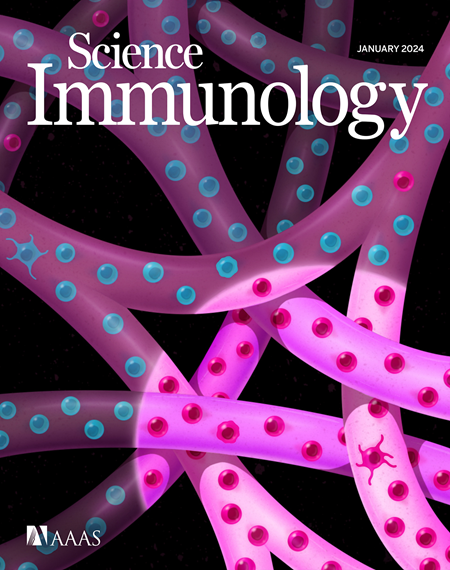Epidermal ZBP1 stabilizes mitochondrial Z-DNA to drive UV-induced IFN signaling in autoimmune photosensitivity
IF 17.6
1区 医学
Q1 IMMUNOLOGY
引用次数: 0
Abstract
Photosensitivity is observed in numerous autoimmune diseases and drives poor quality of life and disease flares. Elevated epidermal type I interferon (IFN) production primes for photosensitivity and enhanced inflammation, but the substrates that sustain and amplify this cycle remain undefined. We show that IFN-induced Z-DNA binding protein 1 (ZBP1) stabilizes ultraviolet (UV) B–induced cytosolic Z-DNA derived from oxidized mitochondrial DNA. ZBP1 is up-regulated in the epidermis of adult and pediatric patients with autoimmune photosensitivity. In patient-derived samples, lupus keratinocytes accumulate extensive cytosolic Z-DNA after UVB exposure, and transfection of keratinocytes with Z-DNA results in stronger IFN production through cyclic guanosine monophosphate–adenosine monophosphate synthase–stimulator of interferon genes (cGAS-STING) activation compared with the more conventional B-DNA. ZBP1 knockdown abrogates UVB-induced IFN responses, whereas overexpression results in a lupus-like phenotype with spontaneous Z-DNA accumulation and IFN production. Our results highlight Z-DNA and ZBP1 as critical mediators for UVB-induced inflammation and uncover how type I IFNs prime for cutaneous inflammation in photosensitivity.表皮ZBP1稳定线粒体Z-DNA,驱动紫外线诱导的自身免疫性光敏IFN信号
在许多自身免疫性疾病中观察到光敏性,并导致生活质量差和疾病发作。表皮I型干扰素(IFN)产生的升高引发了光敏性和炎症的增强,但维持和放大这一循环的底物仍不清楚。我们发现ifn诱导的Z-DNA结合蛋白1 (ZBP1)稳定紫外线(UV) b诱导的来源于氧化线粒体DNA的细胞质Z-DNA。ZBP1在成人和儿童自身免疫性光敏患者的表皮中上调。在患者来源的样本中,UVB暴露后,狼疮角质形成细胞积累了大量的胞浆Z-DNA,与更传统的B-DNA相比,Z-DNA转染角质形成细胞通过环鸟苷单磷酸腺苷单磷酸合成酶干扰素基因刺激因子(cGAS-STING)激活导致更强的IFN产生。ZBP1基因敲低可消除uvb诱导的IFN反应,而过表达则导致狼疮样表型,自发的Z-DNA积累和IFN产生。我们的研究结果强调了Z-DNA和ZBP1是uvb诱导炎症的关键介质,并揭示了I型IFNs如何在光敏性皮肤炎症中起主要作用。
本文章由计算机程序翻译,如有差异,请以英文原文为准。
求助全文
约1分钟内获得全文
求助全文
来源期刊

Science Immunology
Immunology and Microbiology-Immunology
CiteScore
32.90
自引率
2.00%
发文量
183
期刊介绍:
Science Immunology is a peer-reviewed journal that publishes original research articles in the field of immunology. The journal encourages the submission of research findings from all areas of immunology, including studies on innate and adaptive immunity, immune cell development and differentiation, immunogenomics, systems immunology, structural immunology, antigen presentation, immunometabolism, and mucosal immunology. Additionally, the journal covers research on immune contributions to health and disease, such as host defense, inflammation, cancer immunology, autoimmunity, allergy, transplantation, and immunodeficiency. Science Immunology maintains the same high-quality standard as other journals in the Science family and aims to facilitate understanding of the immune system by showcasing innovative advances in immunology research from all organisms and model systems, including humans.
 求助内容:
求助内容: 应助结果提醒方式:
应助结果提醒方式:


